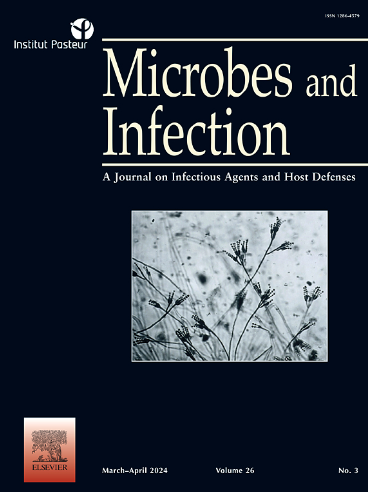High-resolution kinetics and cellular determinants of SARS-CoV-2 antibody response over two years after COVID-19 vaccination
IF 2.7
4区 医学
Q3 IMMUNOLOGY
引用次数: 0
Abstract
Severe acute respiratory syndrome coronavirus 2 (SARS-CoV-2) studies usually rely on cross-sectional data of large cohorts but limited repeated samples, overlooking significant inter-individual antibody kinetic differences. By combining Luminex, activation-induced marker (AIM) and IFN-γ/IL-2 Fluorospot assays, we characterized the IgM, IgA, and IgG antibody kinetics using 610 samples from 31 healthy adults over two years after COVID-19 vaccination, and the T-cell responses six months post-booster. Antibody trajectories varied among isotypes: IgG decayed slowly, IgA exhibited an initial sharp decline, which gradually slowed down and stabilized above the seropositivity threshold. Contrarily, IgM rapidly dropped to undetectable levels after primary vaccination. Importantly, three vaccine doses induced higher and more durable anti-spike IgG and IgA levels compared to two doses, whereas infection led to the highest antibody peak and slowest antibody decay rate compared to vaccination. Comparing with ancestral virus, antibody levels recognizing Omicron subvariants had a faster antibody decay. Finally, polyfunctional T cells were positively associated with subsequent IgA responses. These results revealed distinctive antibody patterns by isotype and highlight the benefits of booster doses in enhancing and sustaining antibody responses.
接种 COVID-19 疫苗两年后,SARS-CoV-2 抗体反应的高分辨率动力学和细胞决定因素。
严重急性呼吸系统综合征冠状病毒 2(SARS-CoV-2)研究通常依赖于大型队列的横断面数据,但重复样本有限,忽略了个体间抗体动力学的显著差异。通过结合 Luminex、活化诱导标记物(AIM)和 IFN-γ/IL-2 Fluorospot 检测法,我们利用 31 名健康成人在接种 COVID-19 疫苗两年后的 610 份样本鉴定了 IgM、IgA 和 IgG 抗体动力学,并鉴定了强化后六个月的 T 细胞反应。不同异型的抗体轨迹各不相同:IgG 下降缓慢,IgA 最初急剧下降,随后逐渐放缓并稳定在血清阳性阈值以上。相反,IgM 在初次接种后迅速下降到检测不到的水平。重要的是,与接种两剂疫苗相比,接种三剂疫苗可诱导更高和更持久的抗尖峰抗体 IgG 和 IgA 水平,而与接种疫苗相比,感染可导致最高的抗体峰值和最慢的抗体衰减率。与祖先病毒相比,识别 Omicron 亚变体的抗体水平的抗体衰减速度更快。最后,多功能 T 细胞与随后的 IgA 反应呈正相关。这些结果揭示了不同异型的抗体模式,并强调了加强剂量在增强和维持抗体反应方面的益处。
本文章由计算机程序翻译,如有差异,请以英文原文为准。
求助全文
约1分钟内获得全文
求助全文
来源期刊

Microbes and Infection
医学-病毒学
CiteScore
12.60
自引率
1.70%
发文量
90
审稿时长
40 days
期刊介绍:
Microbes and Infection publishes 10 peer-reviewed issues per year in all fields of infection and immunity, covering the different levels of host-microbe interactions, and in particular:
the molecular biology and cell biology of the crosstalk between hosts (human and model organisms) and microbes (viruses, bacteria, parasites and fungi), including molecular virulence and evasion mechanisms.
the immune response to infection, including pathogenesis and host susceptibility.
emerging human infectious diseases.
systems immunology.
molecular epidemiology/genetics of host pathogen interactions.
microbiota and host "interactions".
vaccine development, including novel strategies and adjuvants.
Clinical studies, accounts of clinical trials and biomarker studies in infectious diseases are within the scope of the journal.
Microbes and Infection publishes articles on human pathogens or pathogens of model systems. However, articles on other microbes can be published if they contribute to our understanding of basic mechanisms of host-pathogen interactions. Purely descriptive and preliminary studies are discouraged.
 求助内容:
求助内容: 应助结果提醒方式:
应助结果提醒方式:


